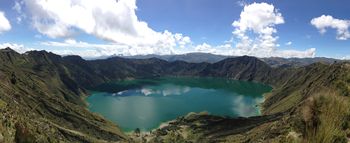Quilotoa: Difference between revisions
Jump to navigation
Jump to search

imported>Joe Quick mNo edit summary |
imported>Joe Quick (planning out a structure for the article) |
||
| Line 1: | Line 1: | ||
{{subpages}} | {{subpages}} | ||
{{Image|Laguna Quilotoa.jpg|right|350px|Laguna Quilotoa (Lake Quilotoa).}} | {{Image|Laguna Quilotoa.jpg|right|350px|Laguna Quilotoa (Lake Quilotoa).}} | ||
'''Quilotoa''' is a [[dacite|dacitic]] [[ | '''Quilotoa''' is a [[dacite|dacitic]] [[volcano]] located in the [[Cordillera Occidental (Ecuador)|Western Cordillera]] of the [[Ecuador]]ian [[Andes]]. It erupted most recently in 1280 AD, producing large [[pyroclastic flow]]s, [[lahar]]s that reached as far as the [[Pacific Ocean|Pacific]] coast, and ash-fall deposits that covered much of present-day northern Ecuador, disrupting the agricultural livelihoods of the pre-Columbian peoples of the region. Today, the volcano is best known for the deep [[volcanic crater lake|crater lake]] within its [[caldera]], which attracts large numbers of domestic and international [[tourism|tourists]]. | ||
==Volcanism== | |||
==Historical Occupation== | |||
==Touristic Development== | |||
Revision as of 17:20, 12 September 2020
Quilotoa is a dacitic volcano located in the Western Cordillera of the Ecuadorian Andes. It erupted most recently in 1280 AD, producing large pyroclastic flows, lahars that reached as far as the Pacific coast, and ash-fall deposits that covered much of present-day northern Ecuador, disrupting the agricultural livelihoods of the pre-Columbian peoples of the region. Today, the volcano is best known for the deep crater lake within its caldera, which attracts large numbers of domestic and international tourists.
